 |
| Reviews and Templates for Expression We |
The battery revolution that will let us all be power brokers
Companies are racing to find better ways to store electricity – and so
provide us with cheaper energy when and where we want it
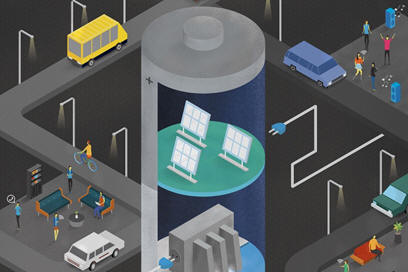
WE ONLY notice them when they are about to run out. Icons glow red, warnings flash. The curse of modern mobility: our battery’s about to give up.
It’s a trivial, everyday annoyance. But the ramifications go far beyond just laptops and smartphones. Humans rely on two things to control their environment: information and energy. Shrinking transistors and the rise of microprocessors have given us immense control over the first: the capacity to store and manipulate data that we hold in the palms of our hands would have been inconceivable a generation ago.
But with energy, we’re stuck in a rut. The development of electric cars stutters forwards thanks to the lack of ways to power them cheaply, efficiently and over long distances. And while we’ve made great strides in harnessing wind, wave and sun to generate cleaner electricity, again, the technology to store that juice lags badly behind.
Corporations and governments are pouring billions of dollars into improving existing battery technologies – with some success. But if we are to continue to compute and communicate with more freedom, while liberating ourselves from our dependence on fossil fuels, conventional thinking needs an overhaul. We’re going to need a better battery.
The cutting edge of current energy storage technology is probably in your pocket right now – and 2 billion others around the world. The lithium-ion batteries that power most smartphones were born in the early 1990s as a quirk of the dying cassette tape industry. The rise of compact discs had Japanese company Sony casting around for something to do with old equipment for making tapes, says Jeff Chamberlain of Argonne National Laboratory in Chicago. Instead of coating the tape with magnetic film that could record data, they started coating it with goopy layers of an electrode that could store electric charge.
Serendipitous find
The first lithium-ion batteries contained rolls of these film electrodes, wound up in a cylinder like the spool of a cassette. They were instantly twice as good as anything else out there for compact energy storage. Existing nickel-cadmium and nickel-metal hydride batteries used chemical changes on the surface of two electrodes within them to shunt charge-bearing hydroxide ions and protons this way and that, and so charge and discharge. The new technology achieved the same by exchanging lithium ions, but slotting them into and out of nanoscale gaps within the material of the battery’s electrodes in a chemical process called intercalation.
Because it is a light metal, lithium has a lot of charge-carrying ions for its weight, making for batteries that are smaller but more powerful. Lithium-ion batteries boomed from their serendipitous beginnings, driven first by the rise of personal electronic devices such as camcorders, and then mobile phones and laptops. Although they are still dwarfed in most respects by the bulky lead-acid batteries found in almost every car on the road today, in 2015, lithium-ion batteries will account for around a third of the money spent on rechargeable batteries globally (see “Turn it on”), and just under a sixth of the total energy stored, according to French research firm Avicenne.
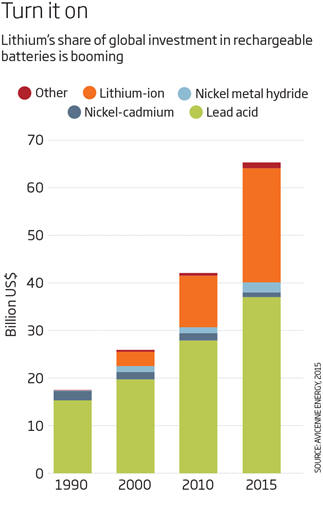
At the same time, their performance has improved immensely: design tweaks have tripled the energy stored in a given volume since the technology was commercialised in 1991. Success has bred success, and lithium-ion batteries have found new and bigger applications, such as electric vehicles (see “Powered by Lithium”). For example, the Model S electric car designed by Tesla Motors, a company owned by serial entrepreneur Elon Musk, is powered by thousands of small lithium-ion batteries arrayed between the car’s axles. It can go from zero to 95 kilometres an hour in 3.1 seconds, and can travel about 430 kilometres on a single charge, although charging it can take many hours.
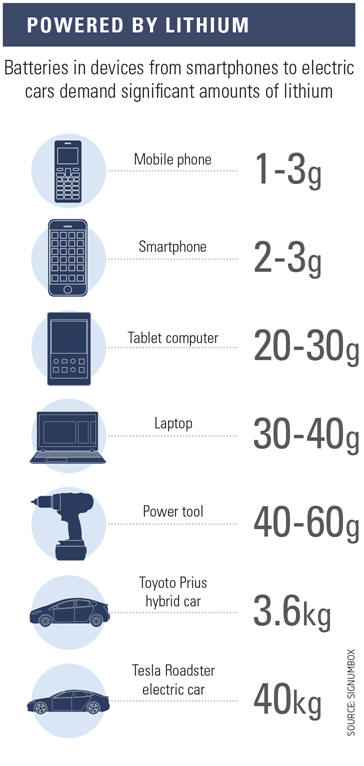
Tesla has no plans to stop there. Lithium-ion batteries are so important to the company that it has taken manufacturing into its own hands, building a “Gigafactory” just outside Reno, Nevada. By 2020, the company plans to produce as many lithium-ion batteries annually as the entire world produced in 2013 – enough for a fleet of 500,000 electric cars – and with a 30 per cent reduction in production cost per battery.
Although a cloak of secrecy surrounds Tesla’s plans, achieving those goals probably means changing the way lithium batteries are made. For all their collective oomph, the thousands of batteries in a Model S are essentially just descendants of those first cylindrical film batteries. “For almost 25 years we’ve been using a suboptimal manufacturing process just because it was there,” says Chamberlain. “Now that lithium-ion is a $15 billion business, big companies are taking notice.”
“Now lithium-ion batteries are a $15 billion business, big companies are taking notice”
And it’s not just big companies. One small start-up, 24M, based in Cambridge, Massachusetts, has attracted more than $50 million of investment for an alternative manufacturing method. Instead of using ovens to dry the slurry that contains the battery’s positive and negative electrodes, the company has found a way to keep the entire process wet, saving time, simplifying the design and boosting the energy density. The company also claims its method will cut the cost in half. “If it works, everyone else will do it instantly,” says materials scientist George Crabtree of Argonne.
Too hot to touch
Crabtree’s Argonne colleague Chamberlain is part of a consortium of companies and researchers with their own plans to improve lithium-ion batteries. As with Tesla, the details remain confidential, but the idea is to take coatings normally used to improve the longevity of artificial joints, and apply them to making batteries with dry electrodes. A number of processes are being tested, Chamberlain says, with the aim of finding what approach provides the most bang for the buck.
Lithium-ion technology has huge momentum, which means it’s likely to form the backbone of our emerging energy-control infrastructure for some time. But it is not without problems. Lithium burns hotly, so batteries that contain it can be a fire hazard if their cells get overcharged. In 2006, Sony recalled 6 million laptop batteries that had been spontaneously combusting. In January 2013, batteries in one of Boeing’s next generation Dreamliner aircraft caught fire while the craft was sitting empty at Boston’s Logan Airport. Boeing has since updated its software, and modern systems generally have the problem under control – but a technology that requires tight oversight to avoid catching fire is hardly ideal.
Other problems are less easily fixed. Lithium-ion batteries are approaching fundamental electrochemical limits on the density of energy they can store, while their cost is nearing its floor, too – something particularly problematic for larger-scale applications. “You might get it down by 30 per cent, but you’re not going to get more than that,” says Crabtree. “If you really want electric cars to compete with gasoline, you’re going to need the next generation of batteries.”
That means finding a new chemical basis for them, says Rachid Yazami of Nanyang Technological University in Singapore. Engineers have achieved incredible advances with lithium-ion batteries, he says – but not enough to meet increasing demands. “People want to charge electric cars very fast, and they want to run them for 500 miles,” he says.
Lithium makes such an obvious choice for storing a lot of energy in a low mass that many alternative battery designs start off with the element, too. One is a lithium-sulphur battery that stores and releases energy by forming and breaking chemical bonds, instead of slotting ions into structural gaps. These batteries are less prone to catching fire, and although they’re not yet commercially available, they have demonstrated energy densities three times those of the best lithium-ion batteries.

Bolivia’s salt flats are the world’s largest source of lithium (Image: Robin Hammond/Panos Pictures)
Dependence on lithium might not prove to be the best bet, however. For a start, plentiful as the element is, it’s not always easy for international markets to get at. The largest identified resources are in Chile and Bolivia, which between them hold more than 40 per cent of the planet’s known totals (see “Lithium locations”). Here the lithium is found in a chloride brine, together with other metal salts, under the world’s largest salt flats, the Salar de Uyuni. Processing lithium from brines may be cheaper and perhaps less environmentally damaging than mining it from rock. But despite much interest, so far Bolivia has not opened up to any foreign mining companies, insisting instead that any lithium extracted there be used to make products – batteries and electric cars – within its borders for export.
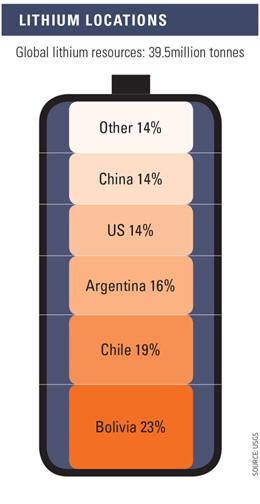
Yazami is one researcher looking at alternative elements to build batteries from. He is coy about his own project, saying only that his lab is working on a system that uses materials far more common than lithium. “If I tell you I can develop a battery that can be charged in 15 seconds and last one week, you’d be happy,” he says. “That’s what we’re doing.”
In general, with an entire periodic table of elements for the taking, trial and error has long been the only way that better batteries have been found. “Traditional battery research is empiricism,” says Chamberlain. “You use knowledge to investigate a material, then test that material.”
“Better batteries would enable the democratisation of electricity”
That’s changing, though, and we’re beginning to use the spoils of the information revolution to spark a similar revolution in energy. Supercomputers are one such tool, making it possible to crunch through many combinations of elements in different proportions and optimise properties such as energy density and charging time. “We’re using that data to find the needles in the haystack of possible materials,” says Chamberlain.
One such system is the Electrolyte Genome, a program designed by researchers at Argonne in collaboration with Lawrence Berkeley National Laboratory in California that sifts through thousands of potential battery chemistries to find promising candidates. On the back of that, Argonne researchers recently built a prototype battery that uses magnesium ions instead of lithium to carry and store charge. Magnesium ions have two positive charges compared with lithium’s one, doubling their capacity to store energy. However, they mostly appear only in bulky combinations with other elements – a problem the simulations are suggesting new ways to get around.
Another target for the computational approach are flow batteries, in which the storage material is all dissolved in solution, allowing for a particularly wide range of elemental mixes. Flow batteries have lower energy densities than other cutting-edge technologies, but are much cheaper. “We’re looking for clever active elements or molecules to store and release the energy, organics that are really abundant, cheap and versatile,” says Crabtree. So far 16,000 have been tested computationally.
Storing sunlight
Reducing the cost of reasonably good batteries might actually prove more important than improving their energy density, says Jeff Dahn of the University of Dalhousie in Nova Scotia, Canada. For instance, the Model S is a fantastic car in many ways, he says, and “the only issue with the thing is that it costs too much”.
“Good batteries are like needles in the haystack of all possible materials”
That certainly becomes true when we look beyond electric cars to an even more pressing energy problem: how to store electricity on the grid. Demand for electricity varies through day and night and through different seasons. Currently, the energy needed to meet peaks in demand is stored in the form of natural gas and coal. These fossil stores sit around in back-up power plants that ramp up when demand is high.
Renewable energy sources such as solar, wind and wave just compound this unpredictability: changes in local cloud cover, wind speed and the like produce irregular peaks and troughs that do not necessarily correspond with spikes in demand. “Shifting to solar and wind, we can’t move the power up and down. We can’t control it. We can’t dictate when the wind blows or the sun shines,” says Chamberlain. “So we have to store the sunlight somehow.”
Our century-old model of electricity distribution is behind the problem, leaving us needing to use electricity as soon as it is generated. On 20 March this year, for example, a solar eclipse knocked out two-thirds of Germany’s solar generation capacity for about an hour. Grid operators, aware of the impending shortfall, spun up alternative generation from coal, gas and hydroelectric systems to meet it. With sufficient battery storage, though, the eclipse would have been a non-event from the start.
But batteries for grid storage will have to be very cheap to compete with fossil fuels as an on-demand energy source. “It’s a very inexpensive way to meet our energy needs to drill a hole in the earth,” says Chamberlain. “After years of engineering we’ve gotten to a place where that’s a very profitable, effective way to get the energy we need.”
Of all the ways to store energy, lithium-ion batteries are one of the most expensive. Yet, with some coaxing, grid storage is already happening using this technology. California signed a bill into law in 2014 that requires its energy companies to bring 1.3 gigawatts of storage to the grid by 2022 – about the same as the output of a large natural gas power station, and sufficient to cover about 1/40th of the state’s average power needs at any one moment. Its purpose is to capture renewable energy at off-peak times, then feed it back into the grid when demand is high.
Responding to that initiative late last year, utility company Southern California Edison commissioned Virginia-based start-up AES Energy Storage to build a gigantic lithium-ion array. Planned to be the largest battery ever built, it will be capable of delivering 100 megawatts of power for four hours, enough to supply 80,000 average US homes. “When you crunch the numbers, that procurement is half a billion dollars being spent on the grid, because of one state’s policy,” says Chamberlain.
Other companies such as Samsung and Siemens already offer products to back up grid power, but they are still expensive compared with fossil-fuel storage, and provide cover only for short periods. Doing the same thing across the entire grid is a mammoth task. “The scale is unimaginable,” says Dahn, whose lab signed a five-year research contract with Tesla in June. He calculates that storing the output of just his local utility company, Nova Scotia Power, for 24 hours would take the energy storage capacity of every battery made worldwide this year – and then half as much again.
In the end, the solution might lie on a smaller scale: giving everyone the power to store their own power. Tesla is one company of several in this game: it recently announced a device called the Powerwall, designed for homes and businesses. It uses the same batteries as electric cars to store energy, either from renewables or cheap night-time electricity, ready to be used during the day.
If such systems become commonplace, we might all become a little more aware of where our energy is coming from, and how our own behaviour affects its use and production, says energy researcher Philipp Grünewald of the University of Oxford. “Batteries would be a really helpful thing to give you a sense that you’ve got something you can trade,” he says. He foresees a system where electricity providers put a small battery in customers houses for free, offering them cheaper rates in exchange for being able to manage that slice of energy storage for the good of the grid at large. That, however, would require buy-in from companies and consumers alike.
Chamberlain says it’s hard to predict what changes the world will undergo if the battery revolution comes off – just as the consequences of the information revolution would have been hard to predict a decade or so ago. But he expects a similar empowerment as individuals gain the ability to produce, store and use electricity at will. “Batteries are a linchpin that would enable democratisation of electricity,” he says.
And as a growing global population demands ever more energy, the next generation of batteries can’t come soon enough (see “Global Lithium Demand”). “We are now at the edge of a new energy revolution,” says Yazami. “We know fossil fuels are not a good solution. But without energy it’s the end of the story.”
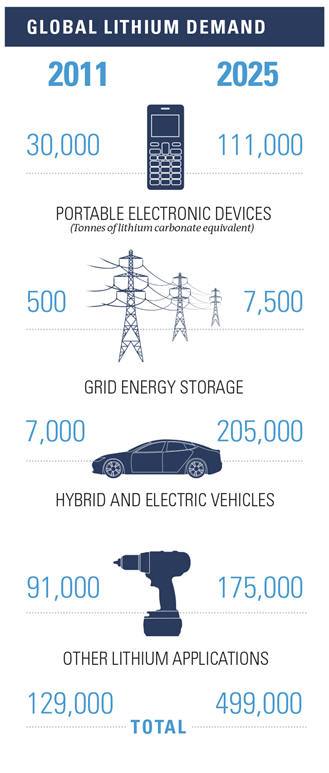
Put that way, batteries become a technology of global importance, and not just to help avert dangerous climate change. “[The US] spends over a billion dollars a day to import energy in some form of petroleum,” says David Howell of the Office of Vehicle Technologies in the US Department of Energy. “We ship a billion dollars offshore a day. That opens us to all kinds of vulnerabilities.”
Grünewald agrees. “If we don’t want fossil fuel based electricity in 2050, then storage will be absolutely vital,” he says. “That starts today.”
|
|
|
|
Copyright 2011 Energy and Technical Services Ltd. All Rights Reserved. Energyts.com |